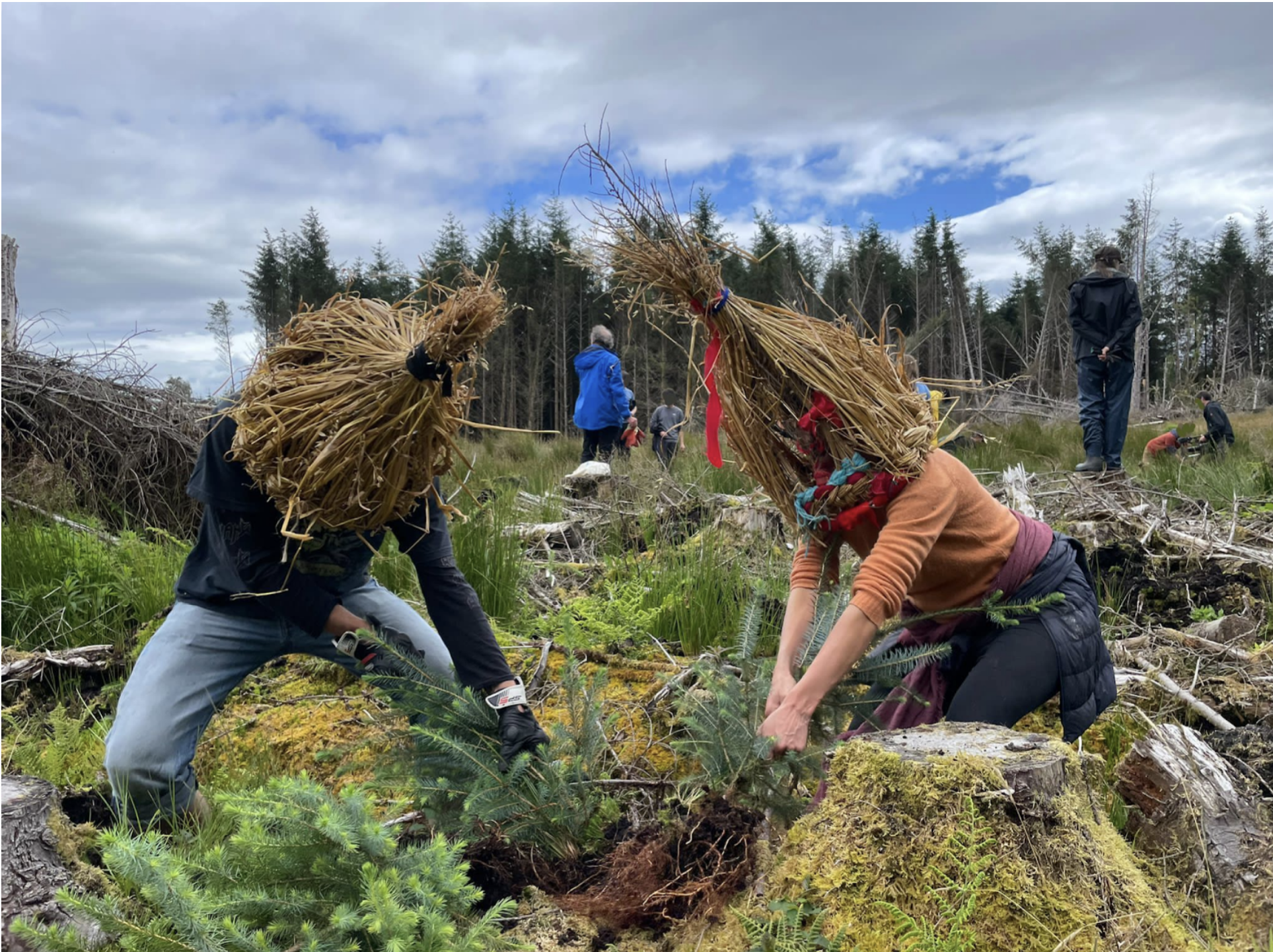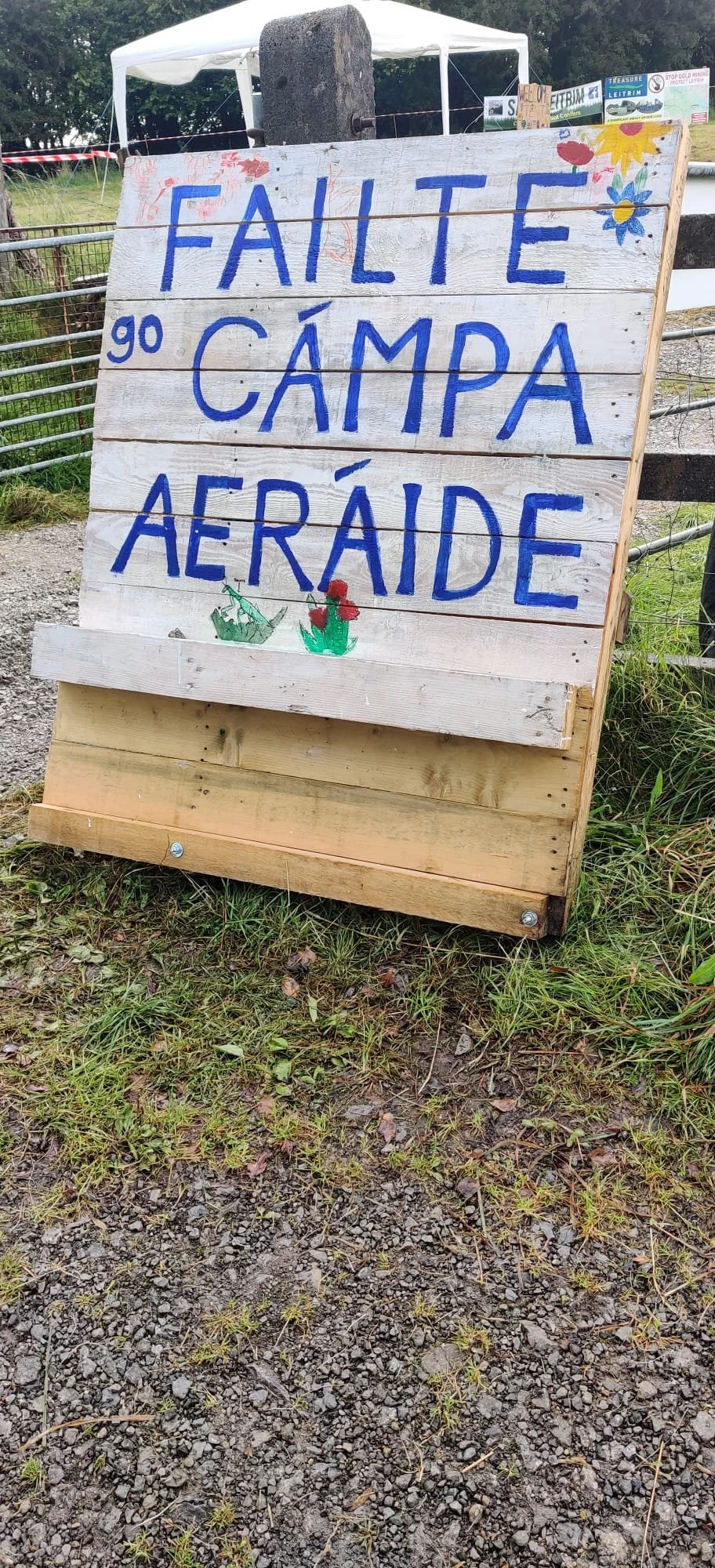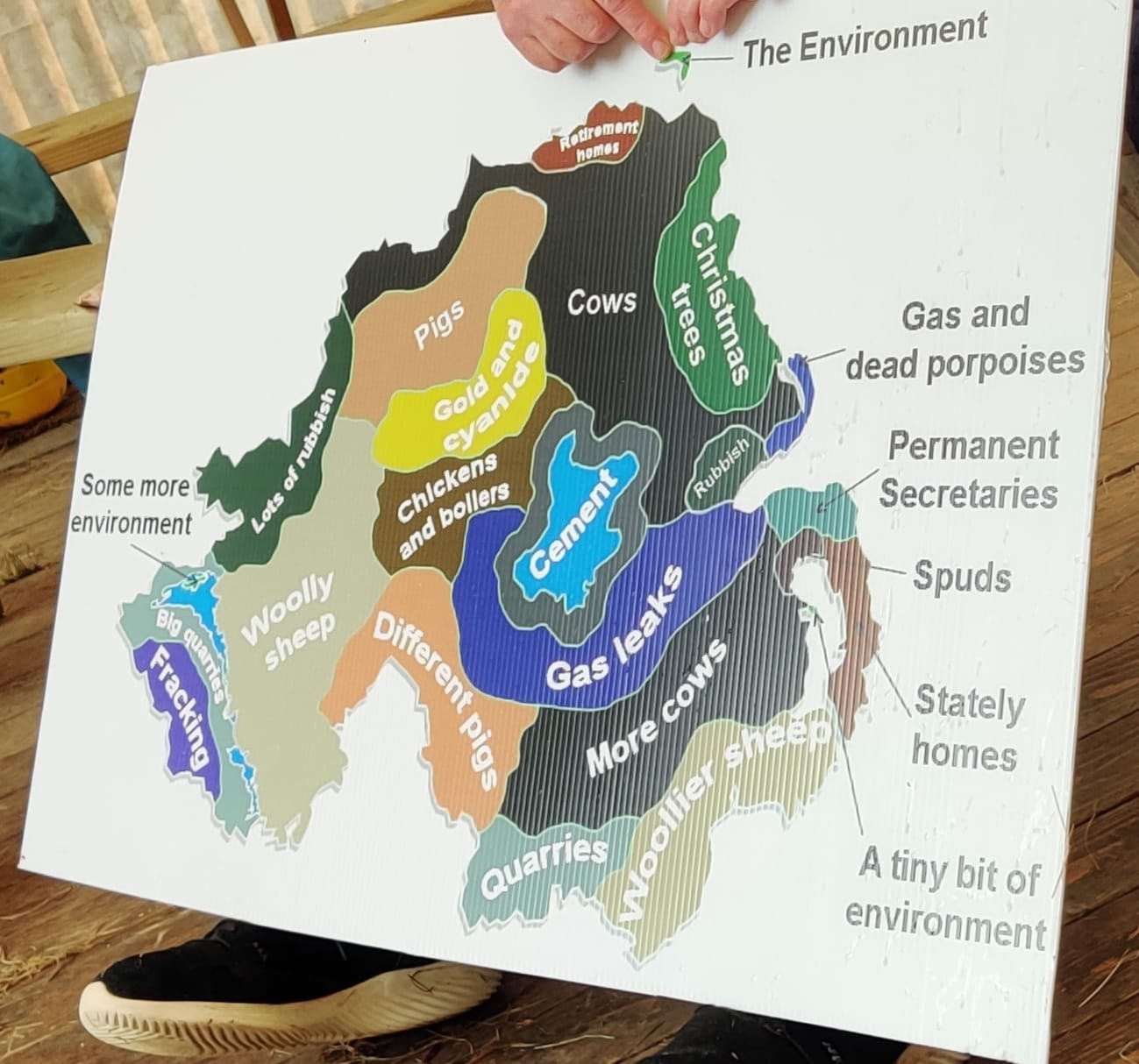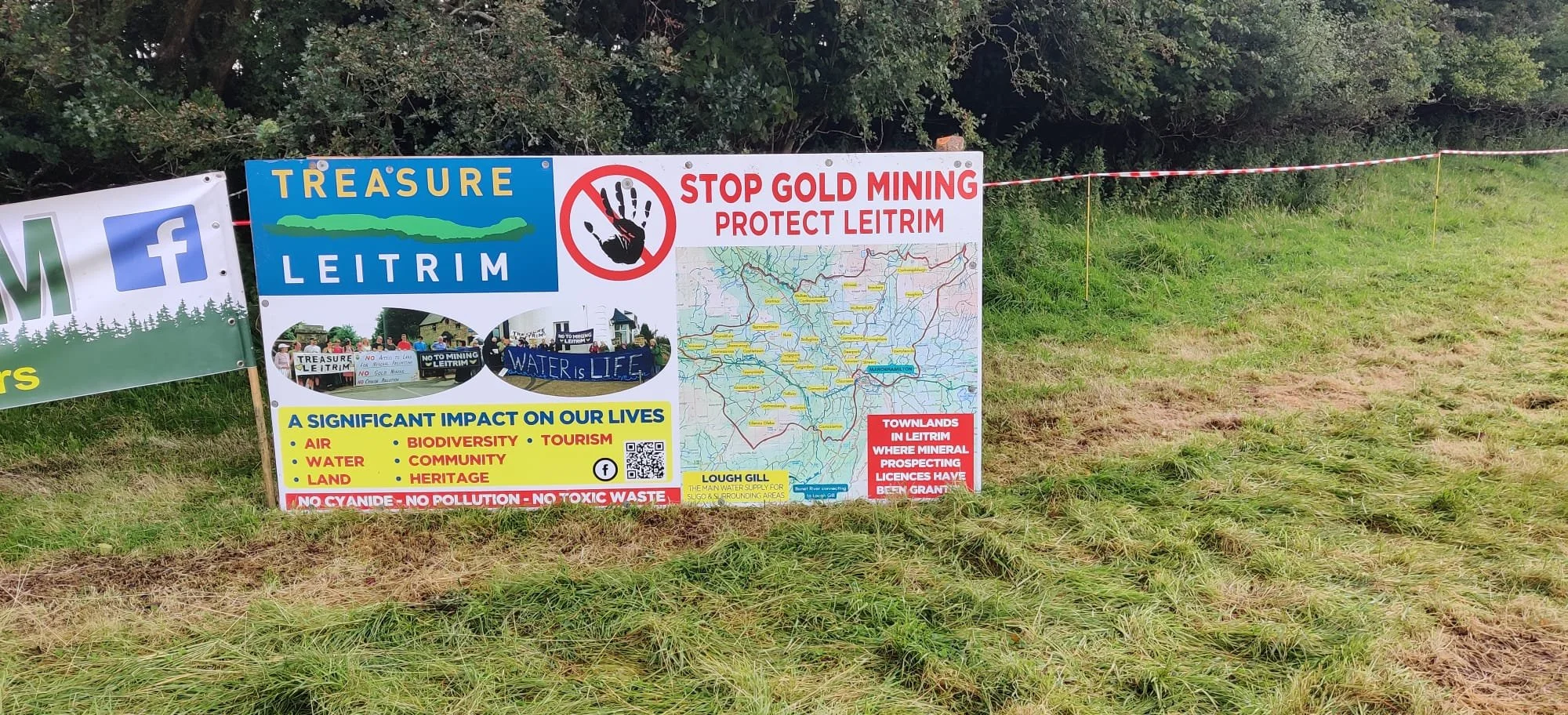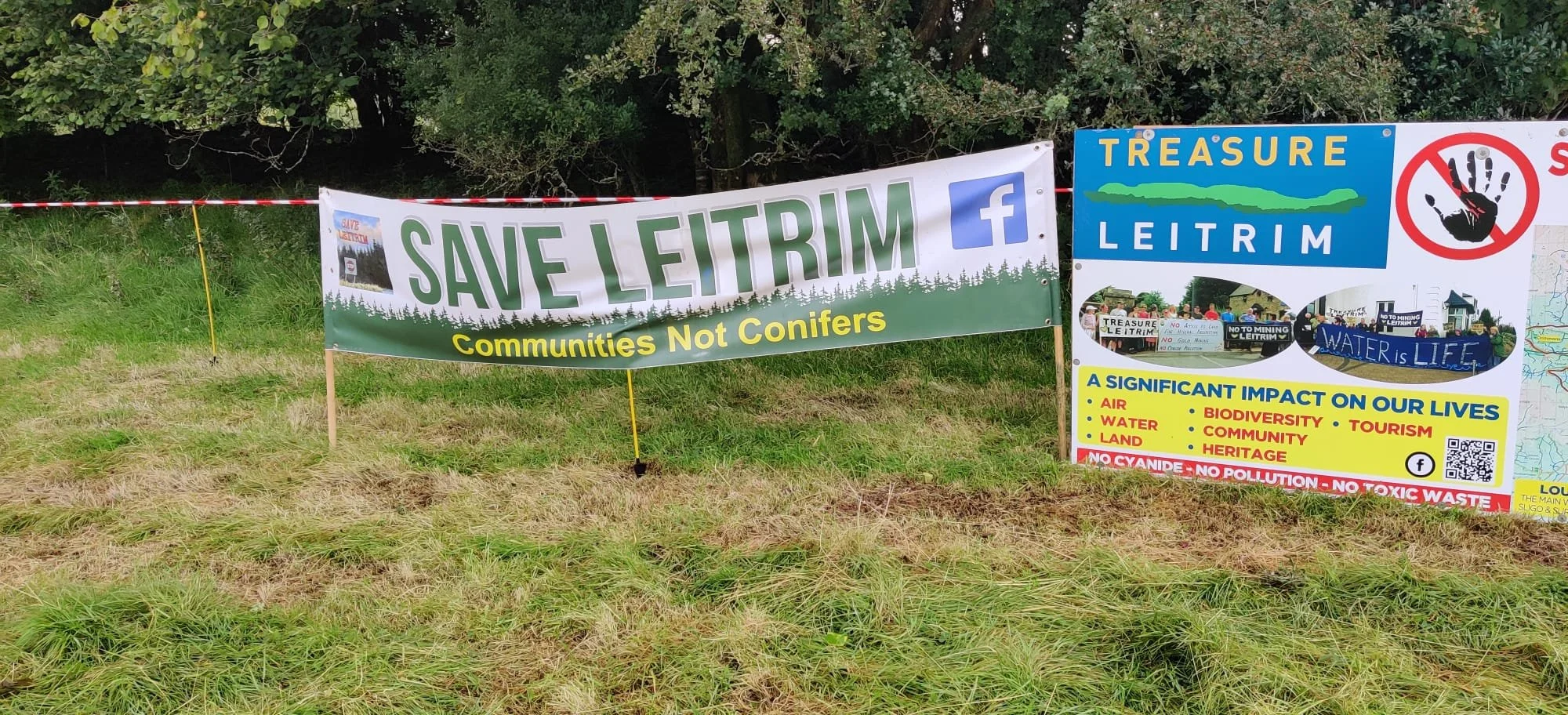‘Communities not shareholders’ — report from Climate Camp 2023
Ruairí Fahy
This August we bring you not one, but two reports on anti-capitalist, environmentalist summer camps. Last week we published a report from RISE & Ruptures Ecosocialist Summer Camp, this week we are delighted to have a report by Ruairí Fahy of PBP Limerick on Slí Eile’s ‘Climate Camp’ which took place August 9th to 13th in Leitrim.
“Straw boys” pull out Sitka saplings from Coillte owned plantation in Leitrim (Image care of Slí Eile)
Climate Camp is a gathering of climate activists, local community campaigners, farmers and others to share skills and strategies for building a radical climate movement across the island and to “reconnect to land and each other.”
Last year the primary focus of the camp, which was held in Ballylongford, Co. Kerry, was to tackle the planned fracked gas import terminal and 500MW gas plant.
This year the camp was held just outside Manorhamilton, Co. Leitrim with the focus on the expansion of Sitka forestry plantations under the guise of climate action as well as the threat of an “onshoring” of mining as over 25% of the island is under licence for prospecting.
The programme for the camp included great discussions on a range of ecological and anti-capitalist topics including “Abolition and Climate Justice,” “Impacts of Climate Change on the Traveller Community,” “Frack Off! Fracking, USA & Shannon LNG,” “Fracking in Northern Ireland,” “Data Centres in Ireland, “ “Communities Against the Injustice of Mining” and “Fossil Fuel Infrastructure projects in NI” along with many others as well as practical discussions like how to carry out bike maintenance and repair, how to make compost and how to develop an agroforestry system.
Farming food, not finance
A discussion on alternative, sustainable forms of agriculture was chaired by James Gilmartin of Treasure Leitrim. In his introduction to the topic he said “most farmers don’t want to leave their land worse off for the people coming after them” but the current model is “based on intensification” where the price per animal is low requiring the intensive use of harmful fertilisers to have enough animals grazing on the land for the business to be profitable.
John Brennan of Talamh Beo added “the CAP [Common Agricultural Policy] is supposed to deliver for farmers out in the countryside but it really delivers for companies, it doesn’t trickle down to small farmers who should be supported to provide public goods.” He also called out the dairy industry for their greenwashing and said we should be laying the blame at the dairy industry not the individual farmers as the large co-ops and dairy processors promote a model of “large scale commodity production with a veneer of Kerrygold” whose ads often depict cattle grazing in low numbers in fields which is far from the reality of farming in Ireland today.
Brigid Murphy, who also works with Talamh Beo, called her experience of farming an “experiment with structural poverty and living with the land” because of how uneconomical it is trying to maintain a farm with 75 sheep and an unfair payment system through the CAP. She makes more money from 10 beehives than from those sheep but believes that “there’s a huge amount of work we need to do on our farms and some of that involves planting trees. We need to be harvesting our own trees and growing our own nurseries” as the trees we buy, primarily from the Netherlands, are not holding up to the rough, windy, west coast of Ireland.
Other important points raised in the discussion surrounded the use of low stocking levels with appropriate animals to facilitate soil development, the value of pollinator strips for increasing crop yields, how fear is being weaponised by the IFA and the far-right to drive farmers away from sustainable alternatives to the benefit of big agribusiness and the need to develop collectives with a diverse set of skills to build a local, sustainable agricultural system that focuses on providing a comfortable existence for farmers and healthy food for consumers, not one that serves the interests of the market.
How to blow up a Data Centre
In a discussion on Data Centres facilitated by Pat Bresnihan we heard how data centres currently use more electricity than all urban homes and are set to use more electricity than all homes by 2030. The need to stop the further development of Data Centres was backed up by Eoin O'Leidhin of Slí Eile who said we need to “call out these people who portray themselves as ‘green’ supporting more coal burning… for their greenwashing [of data centres].” Aaron Downey, of “Friends of the Earth,” described data centres as “big sprawling beasts in industrial estates” and that their expansion is driven by the “supply side expansion of data” by corporations in the hunt for profit.
Anna Pringle of “Not Here Not Anywhere” outlined how their organisation monitors new planning applications and EPA licence requests and prepares submissions opposing the developments while Ian Lumley of “Friends of the Irish Environment” directed the blame for data centre expansion at the IDA. He also called out ideological judges for using arguments from neoliberal economics to uphold planning permission for data centres on the grounds that their emissions can be handled by the European Emissions Trading System, which he referred to as “financial indulgences.”
In the session I spoke at, I challenged the argument of the necessity of more data centres while also challenging the current number as he explained many of the socially harmful uses of data centres for surveillance, fossil fuel extraction and weapons development. I called out the current government for opposing a bill in the Dáil which would have changed planning legislation to outlaw any new data centres and called on “environmentalists and workers to unite against the development of new tools, marketed as Artificial Intelligence by the companies selling them, which will allow employers to intensify work while also deskilling it and drive down wages, without necessarily providing a better service”.
Under Mining our Environment
A discussion titled “Communities Against the Injustice of Mining” was chaired by Sian Cowman and brought members of groups opposing mining in different parts of the country together to share their experiences and seek to unite against the proposed “Critical Minerals Act.” The Act is making its way through the European Commission and threatens to allow environmental regulations around mining to be rolled back under the auspices of supporting EU “security,” meaning mining would be allowed to cause even more environmental destruction than it currently does to support the arms trade.
A shared current from all of these campaigns is that communities are having to become experts in mining and supply chains to challenge the expansion of mining in their areas — up against companies with armies of lawyers and PR companies as well as more unsavoury elements to target the communities challenging them. Another shared feature of the expansion of mining is how all of the prospecting licences quietly appear in local newspapers with low circulation meaning that it can be a halfway through the consultation period before people have a chance to have their voices heard.
Sean Gallagher of "Save Inishowen from Gold Mining" explained how a large campaign in Inishowen — which is facing some of the worst effects of the lack of regulation of mica in concrete — was thwarted by government departments which rejected the majority of submissions against prospecting in their area claiming that the large numbers were a result of spam or malware. Of over 1,500 submissions only 87 were accepted. In Clare, Jacintha van Roij of “Keep Tulla Untouched” explained how she thought mining would “never come to East Clare, as the Burren is just over there” and how they successfully lobbied Clare County Council to outlaw the use of some chemicals used in the processing of Zinc and other minerals in the County Development Plan. She also alluded to how East Clare and the Shannon Estuary are becoming a “sacrifice zone” as polluting industries are dotted across the region.
In Monaghan, poor mining practices led to a mining collapse that destroyed homes and the local GAA pitch. In the area around Tara Mines, the locals have had to deal with heavier and a higher frequency of trucks over the last few years which has covered everything in dust, led to near constant noise pollution and made roads where children used to play and people used to go for leisurely walks inhospitable. Land has been destroyed and will need maintenance indefinitely to stop waste leaking from the tailings ponds but still the operator is looking to expand, “there is no accountability for mining in this country, Government backs everything.”
Ireland: Open for Exploitation
Fidelma O’Kane of “Save Our Sperrins” provided an insightful, powerful and defiant overview explaining how large mining conglomerate Dalridian is attempting to start mining in the Sperrins in a Special Area of Conservation and Area of Outstanding Beauty and a source for the river Foyle where salmon spawn and the endangered freshwater pearl oysters currently thrive.
She explained how she initially thought that “government and politicians wouldn’t allow anything that would affect our health or the environment” but how they saw Dalridian establishing a community fund and cosying up to politicians and local community leaders in an attempt to clear the way for their mining project.
The group sent some members undercover as investors to the world's largest mining conference, Prospectors and Developers Association of Canada (PDAC) Convention and Trade Show, which takes place in Canada every year and found Sean Kyne, Minister for Communications, Climate Action and Environment at the time, holding a presentation declaring “Ireland Open for Business” for Zinc and Gold mining. In this presentation they saw that the state would provide reimbursement of prospecting costs including an additional premium, lax environmental regulations and a low tax environment.
The Save Our Sperrins movement has been involved in many direct actions against the proposed mining project including mass trespass, a constant occupation of the site and even going so far as one member tying themselves to a drill rig to halt prospecting operations. In response to these actions members have faced assault, threatening phone calls including threats to “put your children in body bags” as well as sexually explicit calls.
She finished by saying that this fight is vital for ensuring a healthy environment for future generations, “they say we’re wasting our time but we say we’re retired we have as long as we’re living.”
The call to action surrounding mining was for a campaign that fights to keep control over how and where mineral extraction takes place on this island in the hands of the Oireachtas rather than the European Commission.
Closing out the camp, attendees took part in direct action, uprooting Sitka saplings, and using them to block drains in the bog while also planting new native broadleaf trees. The overwhelming response to this action has been positive with the usual uninformed responses that these trees actually sequester carbon. The reality is that the process of growing them on bogs leads to the degradation of those bogs which, if kept wet and healthy, are massive carbon sinks as well as hives of biodiversity.
Climate Camp has been a bright light for environmental activism in Ireland. It has brought groups and campaigns together not just on single issues like mining, fossil fuel extraction, forestry plantations or industrial agriculture but uniting them together and seeing them as links of the same chain of extractivist capitalist destruction that can only be broken by mass collective action.

